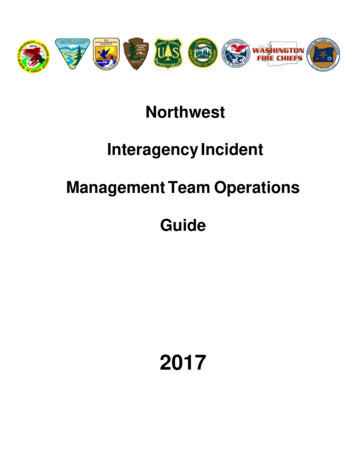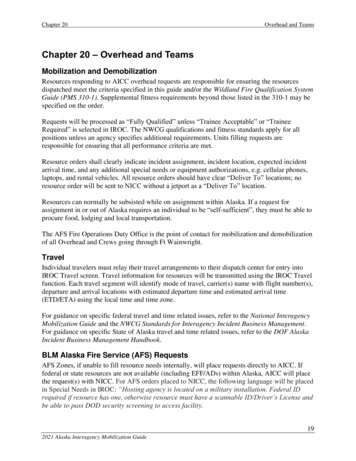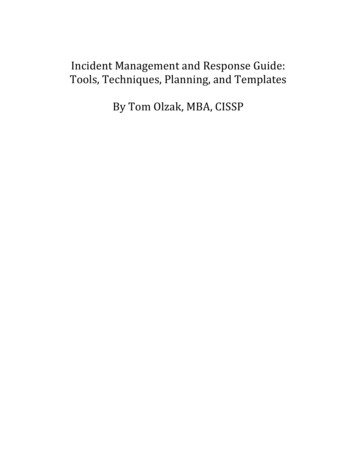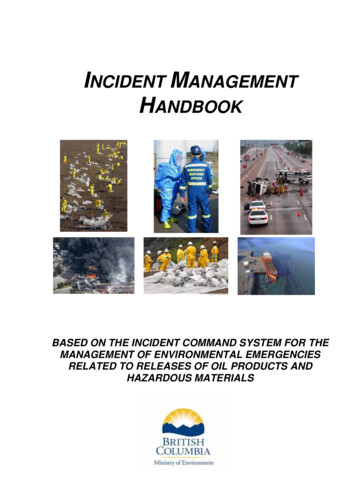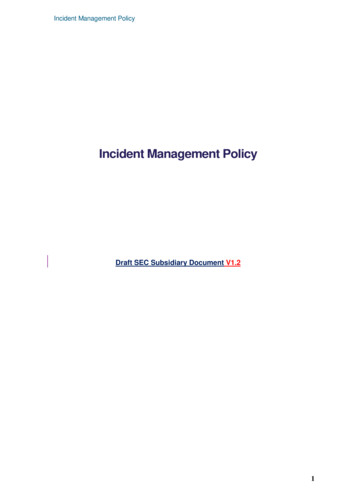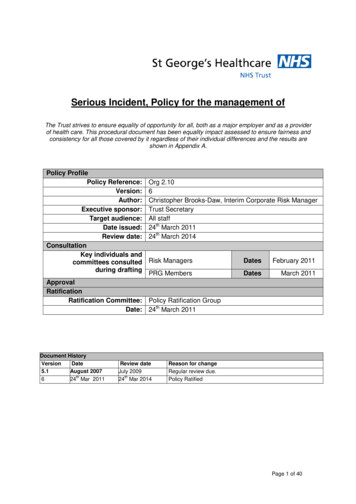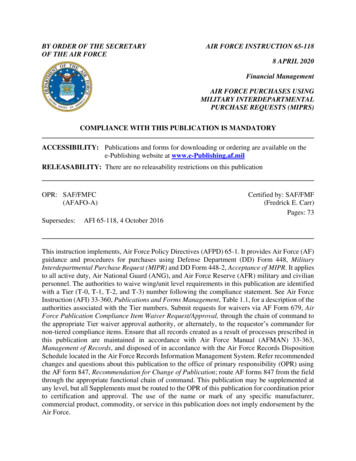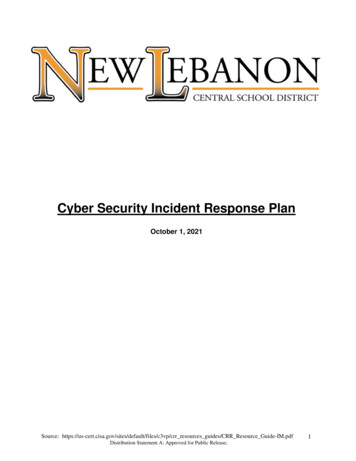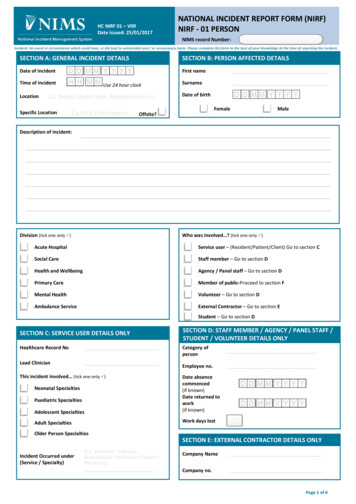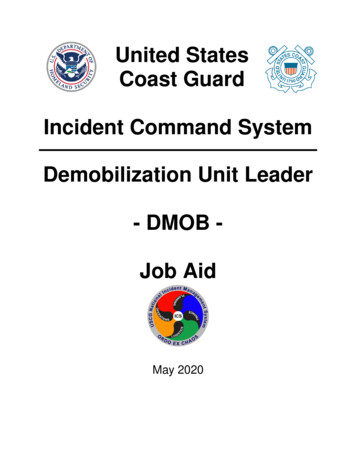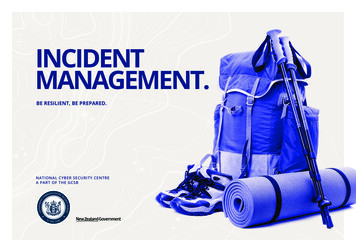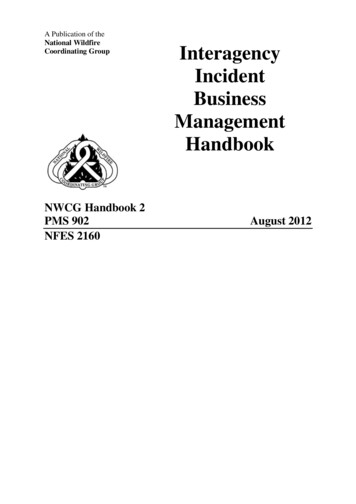
Transcription
A Publication of theNational WildfireCoordinating GroupNWCG Handbook 2PMS 902NFES ugust 2012
Interagency IncidentBusiness ManagementHandbookAugust 2012PMS 902NWCG Handbook 2NFES 2160Sponsored for NWCG publication by the NWCG Incident Business Committee, NationalInteragency Fire Center, 3833 S. Development Ave., Boise ID 83705.Previous editions: 2009, 2004, 2000, 1996, 1991, 1987.This product is posted at http://www.nwcg.gov/. Printed copies may be ordered from theGreat Basin Cache, National Interagency Fire Center, Boise, ID. For orderingprocedures and costs, please refer to the annual NFES Catalog Part 2: Publicationsposted at http://www.nwcg.gov/pms/pubs/catalog.htm.The National Wildfire Coordinating Group (NWCG) has approved this information forthe guidance of its member agencies and is not responsible for the interpretation or useof this information by anyone except the member agencies.NWCG information is in the public domain. Use of this information, including copying, ispermitted. Use of NWCG information within another document is permitted if NWCGinformation is accurately cite to the NWCG. The NWCG logo may not be used except onNWCG authorized information. “National Wildfire Coordinating Group,” “NWCG,”and the NWCG logo are trademarks of the National Wildfire Coordinating Group.The use of trade, firm, or corporation names in this publication is for the information andconvenience of the reader and does not constitute an endorsement by the NationalWildfire Coordinating Group of any product or service to the exclusion of others thatmay be suitable.
INTERAGENCY INCIDENT BUSINESS MANAGEMENT HANDBOOKChapter 0IntroductionChapter 10PersonnelChapter 20AcquisitionChapter 30Property ManagementChapter 40Incident Business Management CoordinationChapter 50Interagency Cooperative RelationsChapter 60Accident Investigation and ReportingChapter 70ClaimsChapter 80Cost Accounting and ReportingChapter 90All-Hazards Incident ManagementAppendix AAcronyms and Position CodesAppendix BTool KitAppendix CGlossary
Table of er iesDefinitions0-10-10-10-40-4Chapter initionsOrganized CrewsCasualsHiring of 16 and 17 Year OldsJob Corps and Youth Conservation Corps (YCC) EnrolleesHiring Federal RetireesVolunteers under Formal AgreementUsing Regular Government Employees from Other FederalAgenciesCooperatorsPay ProvisionsObjectiveResponsibilitiesOne Day Assignments from 0001 to 2400 HoursMultiple-Day AssignmentsLast Day of the IncidentDetail AssignmentsOff-Site/Remote Incident AssignmentsOn-Shift TimeTravel and Related Waiting TimeOrdered StandbyOn-CallOff-Shift TimeMeal PeriodsWork/Rest, Length of Assignment, and Days OffWork/Rest GuidelinesRelease Date: August 0-1810-1910-20Table of Contents - 1
Table of t Operations DrivingLength of AssignmentManagement Directed Days Off at Home UnitOther Pay ProvisionsHazard Pay for General Schedule EmployeesDefinitions for Hazard Pay PurposesPositions Not Entitled to Hazard Pay Differential forIrregular and Intermittent Hazardous DutiesCriteria for Entitlement to Hazardous Pay Differentialfor Irregular and Intermittent Hazardous DutiesRegulations Governing Payment of Hazard Pay Differentialfor General Schedule EmployeesEnvironmental Differential forFederal Wage System EmployeesCriteria for Entitlement to Environmental Differentialfor Federal Wage System EmployeesRegulations Governing Payment of EnvironmentalDifferentialPublic Law 106-558 and Public Law 107-20Fair Labor Standards Act (FLSA) ExemptionModifications for Emergency 810-2910-3010-3110-3210-3310-34Personnel Timekeeping rding ProceduresCrew Time Report, SF-261tTimekeeping MethodsEmergency Firefighter Time Report, OF-288, forRegular Government EmployeesEmergency Firefighter Time Report, OF-288 forCasualsClosing out Emergency Firefighter Time ReportsCommon Timekeeping t 1: Administratively Determined (AD) Pay Planfor Emergency Workers (Casuals)Exhibit 2: Military Time ConversionExhibit 3: State Alpha CodesExhibit 4: Crew Time Report, SF-261 and instructions10-46Table of Contents - 210-4010-4210-4410-4510-4710-4810-4910-50Release Date: August 2012
Table of 627282930313233343536373839404142Emergency Firefighter Time Report, OF-288 for RegularGovernment Employees (Exhibit 5)Emergency Firefighter Time Report, OF-288, forCasuals (Exhibit 6)Employment Eligibility Verification, Form I-9 (Exhibit 7)Checklist for Closing Out Emergency Firefighter TimeReports, OF-288 (Exhibit 8)Single Resource Casual Hiring Form, PMS 934 (Exhibit 9)Incident Behavior Forms, PMS 935-1,PMS 935-2 (Exhibit 10)Exempt / Nonexempt Positions (Exhibit issary Privileges - Payroll DeductionCommissary Privileges – ContractorsAgency-Provided CommissaryOrdering/Receiving ProceduresCommissary Issue RecordPosting Commissary 210-82ExhibitsCommissary Issues Record, OF-287 (Exhibit 12)Commissary Accountability Record,Form OF-284 (Exhibit 13)10-8210-83Compensation For DefinitionsFederal Workers CompensationThe Federal Employees’ Compensation Act (FECA)Coverage Under FECAAuthorizing Medical CareContinuation of Pay (COP)Selection of PhysicianAgency Provided Medical Care (APMC)Authority for APMCAPMC Coverage10-8710-87Release Date: August 0-9610-9610-96Table of Contents - 3
Table of dures to Establish APMCPayment of APMC CostsProcedures for Using APMCProcedures and Documentation Requirements for FederalWorkers’ Compensation (FECA or APMC)Forms DistributionState and Cooperators Workers’ Compensation CoverageExhibitsNotice of Traumatic Injury and Claim for Continuation ofPay/Compensation, CA-1(Exhibit 14)Notice of Occupational Disease and Claim forCompensation, CA- 2 (Exhibit 15)Authorization for Examination and/or Treatment,CA-16 (Exhibit 16)US Department of Labor OWCP District Offices (Exhibit 17)Agency Provided Medical Care (APMC) Authorization andMedical Report, Form FS-6100-16 (Exhibit 18)Sample Incident Injury/Illness Log (Exhibit 19)Emergency Firefighter Time Report, OF-288, showingCOP for Regular Federal Employee (Exhibit 20)Emergency Firefighter Time Report, OF-288, ShowingCOP for a Casual (Exhibit 21)Sample Incident Injury Case File Envelope,OF-313 (Exhibit 22)TravelObjectivePolicyResponsibilitiesIncident Agency RequirementsForeign -11710-11710-11710-11710-121Chapter 20AcquisitionObjectiveAuthorityDelegations of Procurement AuthorityPolicyResponsibilitiesDefinitionsTable of Contents - 420-120-120-120-220-3Release Date: August 2012
Table of sitioning ProceduresIncident Requisitioning Procedures20-420-4Incident Agency Service & Supply Plan20-4Sources of SupplyNational Cache SystemGeneral Services Administration (GSA)National Contracts20-520-520-520-6Acquisition MethodsGovernment Charge Cards and Convenience ChecksLand Use and Facility Rental AgreementsEquipment RentalOrdering EquipmentGeneral Guidelines for Equipment HireHiring MethodsIncident Only EERAs20-720-720-820-920-920-1020-1220-12Unique ItemsAgency Provided Commissary RequisitionsAgency Provided Commissary AcquisitionCommissary ReturnsGovernment Telephone SystemsAgency Provided Medical Care (APMC)Subsistence and Lodging 0-1420-1520-1520-1720-1820-18EERA and I-BPA s DistributionEquipment ReleaseContract mergency Equipment Rental Agreement and IncidentBlanket Purchase AgreementNational Interagency Fire Center (NIFC) Contracts20-25Release Date: August 201220-2520-26Table of Contents - 5
Table of sEquipment and Method of Hire National Standards(Exhibit 23)20-28Resource Order Form, ICS-259-9 (Exhibit 24)Emergency Equipment Rental Agreement,OF-294 (Exhibit 25)Vehicle/Heavy Equipment Safety InspectionChecklist, OF-296 (Exhibit 26)Emergency Equipment Shift Ticket,OF-297 (Exhibit 27)Emergency Equipment Use Invoice,OF-286 (Exhibit 28)Emergency Equipment Fuel and Oil IssueOF-304 (Exhibit 29)Emergency Equipment Rental-Use Envelope,OF-305 (Exhibit 30)Solicitation/Contract/Order for CommercialItems, SF1449 (Exhibit 31)Incident Demobilization Vehicle SafetyInspection, ICS-212 (Exhibit -76Chapter 30Property erty Management Program ProceduresIncident Base Security/StorageProperty Receipting ProceduresIdentificationProperty Accountability ControlsClearance and Demobilization g At Incident Base30-9ExhibitsInteragency Incident Waybill, OF-316 (Exhibit 33)Incident Replacement Requisition,OF-315 (Exhibit 34)Table of Contents - 630-1030-1130-15Release Date: August 2012
Table of perty Loss and Damage Report,OF-289 (Exhibit 35)30-19Chapter 40Incident Business Management -140-1Incident Agency Coordination40-1Incident Management Team (IMT) Coordination40-3Buying Team Coordination40-4Administrative Payment Team (Apt) Coordination40-4Incident Information Technology Coordination40-5Other Team Coordination40-6ExhibitsTime Unit Incident Finance Package (Exhibit 36)Commissary Unit Incident Finance Package (Exhibit 37)Compensation for Injury Unit Incident FinancePackage (Exhibit 38)Claims Unit Incident Finance Package (Exhibit 39)Procurement Unit Incident FinancePackage (Exhibit 40)Cost Unit Incident Finance Package (Exhibit 41)40-640-740-840-940-1040-1140-13Chapter 50Interagency Cooperative l AgreementsAgreements between U.S. Government AgenciesExecutive Agency or Departmental LevelBureau LevelArea LevelLocal LevelRelease Date: August 201250-150-150-150-150-250-250-250-250-2Table of Contents - 7
Table of ments with TribesAgreements between Federal and State Fire OrganizationsAgreements with Other Governmental EntitiesCost Share Agreements for Multi-Jurisdiction Incidents50-350-350-350-3State Management AssistanceAuthorityProcessMilitary InvolvementAuthorityResponsibilityModular Airborne Fire Fighting System(s) (MAFFS)Military Costs and Billings50-450-450-450-550-550-650-650-6Chapter 60Accident Investigation and ReportingAccident Investigation and Reporting60-1Chapter tions70-170-270-4Claims Investigations70-5Claims FilingContract ClaimsTort ClaimsClaim Documentation RequirementsIncident ProceduresNon-Tort ClaimsEmployee ClaimsInformation to be Provided to the ClaimantIncident ProceduresGovernment ClaimsGovernment Property -12Claims Processing70-12Table of Contents - 8Release Date: August 2012
Table of itsMotor Vehicle Accident Report, SF-91 (Exhibit 42)Statement of Witness, SF-94 (Exhibit 43)Claim for Damage, Injury, or Death,SF-95 (Exhibit 44)Employee Claim for Loss or Damage to PersonalProperty, AD-382 (Exhibit 45)Employee Claim for Loss or Damage to PersonalProperty, DI-570 (Exhibit 46)Incident Claims and Accident Log (Exhibit 47)Incident Claims Case File Envelope,OF-314 (Exhibit 48)70-1270-1370-1770-1870-2070-2170-2270-23Chapter 80Cost Accounting and 0-180-3Incident CostsCost CategoriesStandard Component CostsActual CostsEstimated CostsComposite Costs80-380-480-580-580-580-5Cost MethodsInitial EstimationResource Cost Method80-580-580-5Tracking And Reporting MethodsAutomated Cost AccountingSpreadsheetsManual AccountingIncident Status Summary, ICS 209Agency Accrual Reports80-680-680-680-680-680-7Cost Analysis80-7Cost Projection80-7Release Date: August 2012Table of Contents - 9
Table of 627282930313233343536373839404142Chapter-PageCost Share AgreementsCost Shared ItemsNon-Cost Shared ItemsFinal Cost DeterminationTransfer of Responsibility Procedures80-780-880-980-1080-10Cost Share MethodsInitial Attack AgreementYou Order You Pay (YOYP)Acres BurnedCost ApportionmentComplexes/Mergers/Splits d Component Costs (Exhibit 49)Cost-Management Measures (Exhibit 50)Sample Cost Share Agreement (Exhibit 51)Cost Share Agreement Template (Exhibit 52)80-1380-1480-1680-1880-22Chapter 90All-Hazards Incident Business ial Emergency or Major Disaster DeclarationProcessNon Stafford Act Disasters90-190-390-590-590-6Pay ProvisionsBiweekly Earnings LimitationOvertimeHazard PayFair Labor Standards se of Accountable/Sensitive Property90-790-7Property Management90-8Business Coordination90-8Table of Contents - 10Release Date: August 2012
Table of ve Relations90-8Accident Investigations90-8Claims90-8Cost AccountingProcedures for ReimbursementItems Eligible for Reimbursement90-890-890-9AppendixA – Acronyms & Position CodesB – Tool KitC – GlossaryRelease Date: August 2012Table of Contents - 11
INTRODUCTIONCHAPTER 01AUTHORITY234This handbook was developed under the auspices of the National WildfireCoordinating Group (NWCG). The NWCG was formed March 18, 1976, bycooperative agreement between the Secretaries of Agriculture and the Interior.5OBJECTIVE678This handbook was developed to assist participating agencies of the NWCG toconstructively work together to provide effective execution of each agency'sincident management program by establishing procedures for:91011 Uniform application of regulations on the use of human resources,including classification, payroll, commissary, injury compensation, andtravel.1213 Acquisition of necessary equipment and supplies from appropriatesources in accordance with applicable procurement regulations.14 Management and tracking of government property.1516 Financial coordination with the jurisdictional agency and maintenanceof finance, property, procurement, and personnel records and forms.171819 Use and coordination of incident business management functions asthey relate to sharing of resources among federal, state, and localagencies, including the military.20 Documentation and reporting of claims.21 Documentation of costs and cost management practices.22 Administrative processes for all-hazards incidents.23POLICY24252627Uniform application of interagency policies and guidelines are necessary.Agencies will follow the direction set forth in this handbook in all incidentbusiness management functions except where specific agency legal mandates,policies, rules, or regulations direct otherwise.2829303132333435This handbook must be kept current and made available to incident and agencypersonnel. Changes to the handbook may be proposed by any agency for avariety of reasons: new law or regulation, legal interpretation or opinion,clarification of meaning, etc. If the proposed change is relevant to otheragencies, the proponent agency should first obtain national headquarter’s reviewand concurrence before forwarding to the NWCG Incident Business Committee(IBC). The IBC will prepare draft NWCG amendments for all agencies toreview before finalizing and distributing. (Reference the following chart.)Release Date: August 20120-1
INTRODUCTION123CHAPTER 0The IBC maintains a website that contains this handbook, handbooksupplements and amendments and links to geographic and NWCG memberspecific sites.Release Date: August 20120-2
INTRODUCTIONCHAPTER 0New Law, RegulationClarificationNew InformationLegal InterpretationGSA RuleProposed Change(Any Unit)Unit SpecificNoAgency Headquarter’s Review&ConcurrenceYesUnitAnnual Review ofGeographic Area orAgency SpecificSupplementsSubmit toDraft NWCG SupplementReview by All AgenciesComments to NWCG IBCFinal NWCG SupplementDistribution ToAgenciesRelease Date: August 20120-3
INTRODUCTION1CHAPTER 0RESPONSIBILITIES2345 Each agency is responsible for establishing controls to ensurehandbooks are maintained in a current status. Handbooks must beavailable and up-to-date, and the latest revision of forms must be onhand and available to agency and incident personnel.67 Each agency shall maintain a master distribution list for the handbookand ensure distribution of NWCG amendments. www.nwcg.gov891011 Agencies, field offices, or NWCG geographic areas may supplementthis handbook for clarification or information, as long as policy orconceptual data is not changed. Agencies must make supplementsavailable to incident personnel. www.nwcg.gov1213 Agencies may request the IBC review supplements and make changesto the parent text of this handbook if applicable to all agencies.14 The IBC will revise this handbook every 4 years.15DEFINITIONS1617Definitions used throughout this handbook are located in Appendix C Glossary. Specific definitions unique to a chapter are found within that chapter.Release Date: August 20120-4
2627282930313233343536373839CHAPTER 10OBJECTIVEThis chapter provides information and procedures regarding management ofhuman resources, including recruitment, pay, commissary, injury compensation,and, travel. Specific and complete regulations are available from federal or stateHuman Resource offices. Applicable provisions of collective bargainingagreements are not waived.RECRUITMENTRecruiting plans, hiring instructions and operating procedures should bedeveloped by agencies in advance of incidents and include: sources of personnel,age requirements, physical fitness, proper clothing, conditions of hire, wages,and any special procedures pertaining to recruitment and use of personnel. Allpersonnel will be covered 1) under the Administratively Determined (AD) PayPlan for Emergency Workers as a casual; or 2) under a cooperative agreement;or 3) under a contract; or 4) as a regular government employee.RESPONSIBILITIESRecruiting agency responsibilities: Ensure the development of recruiting plans. Provide training and certification. Complete the hiring paperwork.Hiring unit for casual hires responsibilities: Complete the hiring paperwork. Apply the provisions of the AD Pay Plan for Emergency Workers. Ensure incident qualifications are current.DEFINITIONSDefinitions used throughout this chapter are located in Appendix C – GlossaryRelease Date: August 201210-1
2627282930313233343536373839404142CHAPTER 10Organized CrewsOrganized crews under agreements, e.g., crews from other agencies, NativeAmerican crews, agricultural workers, National Guard, and prison inmates, aremanaged in accordance with the terms of those agreements.The agency that establishes the crew agreement is responsible to: Identify incident behavior expectations. Document consequences for inappropriate behavior in the crewagreement. Ensure incident behavior expectations are provided to crew personnel. Establish procedures to document acknowledgement of receipt of thisinformation by crew personnel.Agencies may choose to utilize the Incident Behavior Form, PMS 935. (Exhibit10)Agreements for organized crews, who are hired as casuals, shall comply with theAD Pay Plan. (Exhibit 1)The hiring unit is responsible to screen organized crews before they aretransported to an incident and ensure all crew personnel have proper clothingand meet position and physical fitness qualifications.Crew representatives or crew bosses are responsible to provide a copy of theagreement, upon request, to the incident management team (IMT) or incidentagency to ensure the terms of the agreement are met.Crews provided under contract (known as Contract Crews) are governed by theterms of the contract and the provisions in this chapter do not apply.CasualsSingle resource casuals may be hired locally or through state employmentoffices. Hiring of casuals through a state employment office shall be inaccordance with an agreement and understanding reached prior to the incident onhiring methods and procedures for casuals. Hiring units must adhere to theprovisions in the AD Pay Plan when hiring casuals. Units are responsible fordesignating the appropriate agency hiring official, either by name or position.Release Date: August 201210-2
2627282930313233343536CHAPTER 10Nonresident aliens may be hired and paid as casuals for the duration of anincident (Comp. Gen. B-146142, 6/22/61). The Internal Revenue Service (IRS)requires each nonresident alien to have a valid Social Security number (SSN) atthe time of hire. The Immigration Reform and Control Act of 1986 (SimpsonRodin Act) also requires completion of an Employment Eligibility Verification,I-9 (8 CFR 274a2).Hiring officials will complete the Single Resource Casual Hire InformationForm, PMS 934 (Exhibit 9) at the time of hire and obtain the casuals signature.Retain a copy for the hiring unit and provide a copy to the casual. Followagency policy for disposition of the original. This form is not required whenhiring crews.If the requesting incident agency has identified on the resource order thatelectronic devices such as cell phones, etc. are required to accompany theordered individual, the hiring official will assist the individual with obtaininggovernment issued or acquired property prior to dispatch. If the hiring unit isunable to provide government owned or acquired equipment, advise theindividual to contact the incident assignment supervisor upon arrival.Agencies, IMTs or incident support units should not establish EmergencyEquipment Rental Agreements (EERA) or other federal contracts for personalcomputers, laptops, cellular phones, personal data assistants (PDA), cameras,global positioning systems (GPS), or other electronic devices. The incident unitshould provide these items if required by the position.Federal and state income taxes will be withheld from the casual’s earnings.Casuals must be provided the opportunity to complete appropriate federal andstate income tax withholding forms at the time of hire to ensure the correctamount of tax is withheld.Casual earnings may be subject to Social Security earnings limitations. Casualsshould contact the Social Security office to determine applicability.Casuals are required to adhere to established incident behavior responsibilitiesand may be released if inappropriate behavior occurs.Release Date: August 201210-3
2627282930313233343536373839404142CHAPTER 10Hiring units are responsible to provide the Incident Behavior form to singleresource casuals, ensure the casual signs the form, retain the original form andprovide the casual with a copy. An Incident Behavior form, PMS 935 (Exhibit10) shall be completed annually.Reference Exhibit 1 – Administratively Determined (AD) Pay Plan for keypositions that may only be filled by current agency employees and for directionon hiring state, local and tribal government employees.It is recommended the following positions also be filled by current agencyemployees: Incident Business Advisor (IBA), Finance/Administration SectionChief (FSC), Procurement Unit Leader (PROC), Compensation/Claims UnitLeader (COMP), and Compensation for Injury Specialist (INJR). If these or anyother positions are filled through the use of the AD Pay Plan, the hiring officialis responsible to ensure the individual has maintained current qualifications andexperience.Casuals hired under the AD Pay Plan cannot supervise, hire, order, orrecommend payments that in any way affect a company or contractor the casualhas ownership or employment with, or perform any other financialresponsibilities to, or for, the company or contractor on an incident. If suchworking conditions exist on an incident or other workplace, the casual shallimmediately disclose any relationship with the company or contractor to theimmediate supervisor and the Agency Administrator (AA), IBA, or FSC forimmediate action.Persons hired as casual firefighters must meet the following requirements: Be at least 18 years old. Minimum physical fitness standards as established by agency policy. Minimum training requirements for the position before assignment. Agency security requirements. Have proper clothing and footgear. All small unit leadership, e.g., crew bosses and assistants, squad bossesand/or crew section leaders, engine supervisors (captains) and assistants(engineers), must be proficient in the English language and the languageused by members of their crew/units.Release Date: August 201210-4
26272829303132333435363738CHAPTER 10Hiring of 16 and 17 Year OldsIn accordance with applicable state and federal laws, 16 and 17 year old personsmay be hired. Obtain incident agency policies (state or federal) for hiringregulations http://www.youthrules.dol.gov.Job Corps and Youth Conservation Corps (YCC) EnrolleesJob Corps and Youth Conservation Corps enrollees may be hired as casualsunder the AD Pay Plan. Enrollees age 16 and 17 may be assigned to nonhazardous or nonarduous duties only, e.g., camp support. Enrollees age 18 and over may be assigned to all other incident dutiesat the appropriate AD pay rate.Hiring of Federal RetireesFederal retirees may be hired as casuals under the AD Pay Plan. They must meetthe same hiring requirements as any other casual.Federal retirees who received separation incentive payments, e.g., buyout, maybe subject to repayment of incentive payment if hired as a casual. Retireesshould check with the Office of Personnel Management (OPM) for specificrestrictions.Volunteers Under Formal AgreementVolunteers may be hired as casuals for an incident. While in casual pay status,the provisions of the volunteer agreement do not apply.Using Regular Government Employees From Federal AgenciesIt may be permissible to hire and utilize regular government employees from anyfederal agency as a casual while they are in a nonpay status, e.g., leave withoutpay, furlough, intermittent and regularly scheduled days off (Reference agencyspecific policies).Release Date: August 201210-5
2627282930313233343536CHAPTER 10CooperatorsMilitary Personnel – Except for National Guard (see below), only organizedmilitary personnel groups obtained through official channels may be utilized.Timekeeping for organized military personnel will be accomplished by their ownsupport group.The Comptroller General has held federal civilian employment and military paystatutes are not compatible. The most severe emergency does not justify hiringof members of the Armed Forces since they cannot be compensated (27 Comp.Gen. 510).Active duty military personnel, including those on leave or furlough, cannot becompensated from incident funds and, therefore, cannot be hired as casuals.National Guard – When the National Guard is formally mobilized and orderedout as a unit, payment shall be made according to the applicable agreement.When members of the National Guard are hired as individuals’, they are hiredand paid as specified in the applicable agreement (40 Comp. Gen. 440) or as acasual under the AD Pay Plan.State and Local Cooperators – State employees and local cooperators, e.g.,tribal, rural and county fire departments, are hired and paid as specified in anapplicable cooperative agreement and time is recorded as specified in theagreement. If the cooperative agreement specifies personnel are hired under theAD Pay Plan, time is recorded on an Emergency Firefighter Time Report, OF288.Federal Cooperators – It is permissible to utilize regular government employeesfrom federal agencies on incidents under interagency agreement e.g., GeneralServices Administration (GSA), National Weather Service (NWS). Agencies arereimbursed as specified in the applicable interagency agreement.Permittees – Timber sale contracts and agency permits provide for varying levelsof fire suppression assistance. The FSC ensures time records and payments arein accordance with applicable contracts or permits.Release Date: August 201210-6
2627282930313233343536373839404142CHAPTER 10PAY PROVISIONSOBJECTIVEThe following contains information concerning tours of duty, hours of work, andpay.RESPONSIBILITIESIncident Management Team (IMT) responsibilities: Ensure all pay provisions and regulations are applied and adhered toduring incident management operations.Home Unit responsibilities: Apply agency specific pay provisions and regulations to emergencyincident
One Day Assignments from 0001 to 2400 Hours 10-7 31 . Multiple-Day Assignments 10-7 32 . Last Day of the Incident 10-9 33 . Detail Assignments 10-10 34 . Off-Site/Remote Incident Assignments 10-10 35 . On-Shift Time 10-14 36 . Travel and Related Waiting Time 10-14 37 . Ordered Standby 10-16 38 . On-Call 10-17 39 . Off-Shift Time 10-18 40
